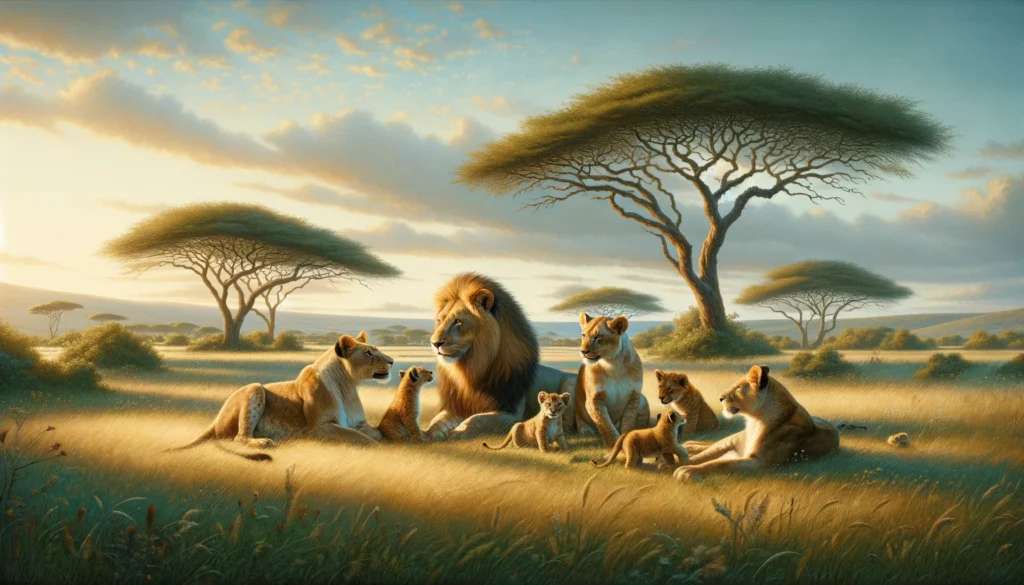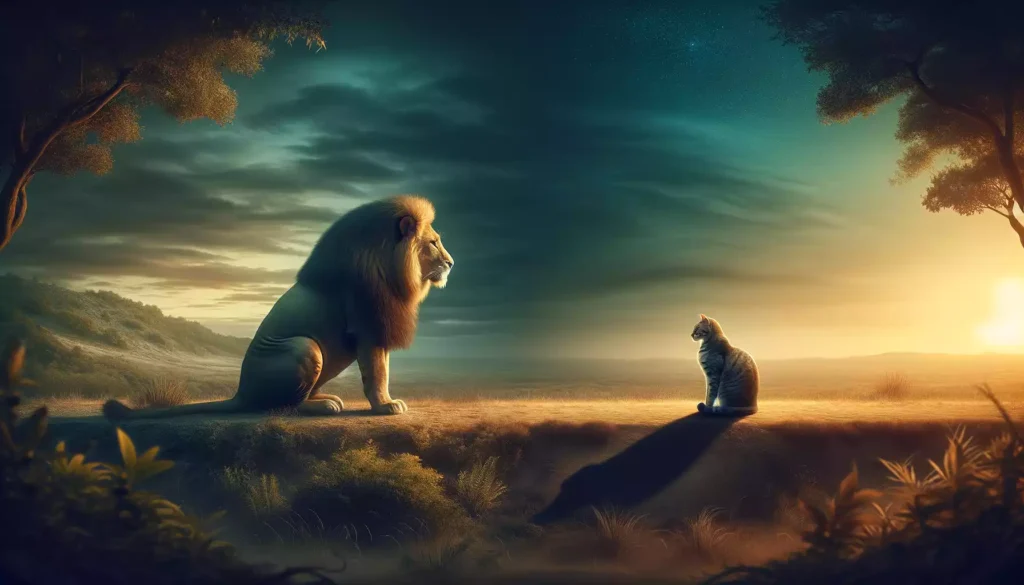The Bond Between Cats and Lions: Exploring Fascinating Similarities
Feline Family, Cats and Lions: An Ancestral Connection
Cats and lions, while both part of the same feline family, present a fascinating blend of similarities and differences that make them equally intriguing. Both share distinctive physical traits such as agility, retractable claws, and a sharp sense of sight and hearing, which make them efficient hunters in their respective environments. The elegance in their movements and their stalking abilities are common skills in both cats and lions, showcasing their shared evolutionary roots. However, cats and lions also differ significantly in various aspects. Cats are small, adaptable domestic animals that have lived alongside humans for thousands of years, providing companionship and pest control.
In contrast, lions are majestic predators ruling over the vast African plains, living in social groups called prides and playing a crucial role in maintaining their ecosystem’s balance. While cats display independence and curiosity, making them unique as pets, lions exhibit complex social behaviour and a hierarchical structure that stands out in the animal kingdom. Exploring the particularities of both cats and lions allows us to appreciate their evolutionary connections as well as the unique adaptations they’ve developed to thrive in such different environments.
Cats, both domestic and wild, and lions are prominent members of the Felidae family. This feline lineage ranges from small felines like the domestic cat to the mighty predators that reign over the African plains. Despite the differences in size and habitat, they all share a common ancestor and a series of physical and behavioural traits that identify them as felines.
Both species, Cats and Lions, exhibit a slender and agile body, perfect for stalking their prey in their natural environment. Their retractable claws are a distinctive feature that allows both cats and lions to keep their weapons sharp for hunting while carrying out daily activities like climbing or grooming. Additionally, their sharp teeth, adapted for tearing flesh, are a vital tool for ensuring their survival in the wild.

This feline lineage is a testament to the incredible adaptability of felines to a wide range of environments, from open steppes to the cosy corners of our homes. Although the life of a domestic cat may seem worlds apart from that of a lion roaring in the savannah, both share an evolutionary legacy that has shaped their anatomy and behaviour over millennia.
This fascinating bond between cats and lions reminds us of the intricate web of relationships that exist in the animal kingdom. By exploring these similarities, we can better appreciate the diversity and unity within the feline family, as well as our connection to the vast natural world that surrounds us.
Discover the Majestic World of Cats and Lions
📸 Stunning Photography: “Cats and Lions” by Mitsuaki Iwago takes you on a visual journey into the lives of these magnificent animals, capturing their grace, power, and beauty in stunning detail.
🐾 From Domestic Cats to Wild Lions: Explore the incredible similarities and differences between house cats and their wild relatives, offering a deeper appreciation for these majestic creatures.
🌍 Perfect for Animal Lovers: This book is a must-have for anyone fascinated by the animal kingdom, featuring breathtaking images and insightful commentary.
🎁 A Beautiful Gift: Ideal for animal enthusiasts, photographers, and those who appreciate nature’s wonders, this book makes a thoughtful and elegant gift.
Behaviour and Socialisation Between Cats and Lions:
Cats and lions, though belonging to the same feline family, exhibit behaviours and social relationships that reflect both their similarities and differences. Both are known for their independence and hunting skills, but the way they interact with their environment and other individuals varies notably. For example, cats are domestic animals that, while they can be affectionate with humans, typically maintain a solitary and territorial nature. Their behaviour includes a mix of play, exploration, and moments of affection, making them fascinating and sometimes enigmatic pets. On the other hand, lions live in complex social groups known as prides, where cooperation and hierarchical relationships are essential for their survival. Male lions protect the territory, and the females hunt as a team, displaying a group dynamic that is rare among large felines. Vocal and gestural communication between pride members is crucial to maintaining social cohesion and hunting efficiency.
Comparing the behaviour and relationships of cats and lions provides us with a deeper understanding of how these felines have adapted their natural instincts to thrive in domestic and wild environments, respectively. Both cats and lions share a fascinating blend of similarities and differences that make them equally intriguing. They both possess distinctive physical traits such as agility, retractable claws, and a sharp sense of sight and hearing, making them efficient hunters in their respective environments. The elegance in their movements and their stalking abilities are shared skills, highlighting their shared evolutionary roots.
However, cats and lions also differ significantly in various aspects. Cats are small, adaptable domestic animals that have lived alongside humans for thousands of years, offering companionship and pest control. In contrast, lions are majestic predators that reign over the vast African plains, living in social groups called prides and playing a crucial role in maintaining the balance of their ecosystem. While cats display independence and curiosity, which makes them unique as pets, lions exhibit complex social behaviour and a hierarchical structure that stands out in the animal kingdom. Exploring the particularities of both cats and lions allows us to appreciate their evolutionary connections as well as the unique adaptations they’ve developed to thrive in such different environments.
Both cats and lions share a common trait: their propensity for solitary life. Both species often hunt and feed alone, relying on their individual skills to survive in their natural environment. This independence allows them to adapt to a wide range of conditions and environments, from dense jungles to the most arid deserts.
However, the idea that felines are exclusively solitary doesn’t tell the full story. Both lions and cats can exhibit social behaviours under specific circumstances. In the case of lions, the formation of social groups, known as prides, is a key strategy for hunting and protecting territory. These prides, primarily composed of related females and their offspring, demonstrate the lions’ ability to cooperate and form social bonds within their community.

On the other hand, domestic cats can also exhibit a degree of sociability, especially in environments where food and resources are plentiful. Cat colonies, formed by individuals sharing a common territory, are an example of how cats can interact with each other in a peaceful and cooperative manner. Although each cat retains its independence, these colonies provide opportunities for communication, play, and mutual protection.
This contrast between solitary life and occasional sociability highlights the flexibility of feline behaviour and their ability to adapt to different environmental and social conditions. Through the observation and study of these behaviour patterns, we can deepen our understanding of the complex inner lives of felines and appreciate the diversity of strategies they employ to survive and thrive in the animal world.
The Art of Hunting: Shared Instincts Between Cats and Lions
Hunting is a fundamental part of feline life, and both lions and cats share similar hunting instincts. From stealthy stalking to strategic ambushes and rapid chases, these creatures have developed a wide array of techniques to capture their prey with efficiency and precision. The ability to blend into their surroundings and move silently allows them to approach their prey undetected, thereby maximising their chances of success in the hunt.
In addition, both lions and cats share a carnivorous diet, meaning they rely exclusively on meat for the nutrients needed to survive. While domestic cats usually hunt smaller prey, such as rodents or birds, lions take on much larger prey like wildebeests, zebras, or even buffaloes. This difference in prey size is largely determined by the size and strength of the felines, as well as the energy demands of their lifestyle.
Despite these differences in preferred prey, the hunting process remains essentially the same for both: stalking, ambushing, and attacking with surgical precision. This similarity in hunting instincts highlights the deep connection between all felines, from the majestic lions dominating the African plains to the small domestic cats curling up in our homes.
Ultimately, the art of hunting is an impressive manifestation of the evolutionary adaptation of felines to their environment and lifestyle. Through the observation and study of these shared instincts, we can appreciate the beauty and complexity of nature, as well as the remarkable diversity of strategies felines use to survive in a challenging and ever-changing world.
Exploring Social Structures and Hierarchies Between Cats and Lions
In the realm of lions, social structure is expressed through the formation of groups known as prides. Within a pride, there is a clearly defined hierarchy, led by a dominant male who oversees and protects the group. This alpha male enjoys privileged access to the females and resources, and his leadership position is secured through physical competition and the active defence of the territory.
On the other hand, domestic cats also exhibit a complex social structure, especially in environments where multiple individuals coexist, such as feral cat colonies or households with several cats. In these situations, hierarchies are established based on dominance and territory. The more dominant cats typically occupy the best spots, such as prime sleeping areas or first access to food, while the more submissive cats adapt to more peripheral roles in the social hierarchy.
Furthermore, the delimitation and defence of territory are fundamental aspects of the social structure for both lions and domestic cats. Lions mark their territory with pheromones and vocalisations, while domestic cats use scent marking and territorial behaviours to establish and maintain their dominance over a specific area.
These social structures and hierarchies are the result of a long evolution and adaptation to environmental and social pressures. Through the observation and study of these dynamics, we can gain a deeper understanding of the complex social life of felines and appreciate the richness and diversity of interactions that occur within their communities.
Visit 1A Lions for more information.
